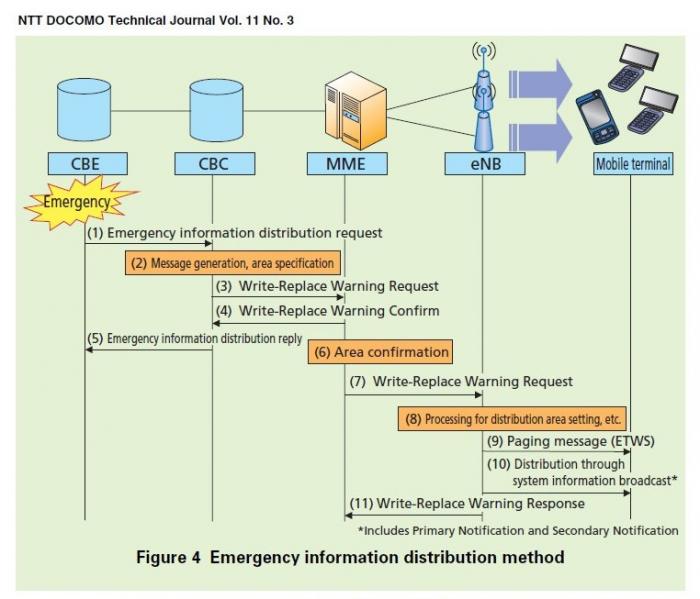
The method of distributing emergency information to LTE radio networks is shown in Figure. When the CBC receives a request for emergency information distribution from CBE, it creates the text to be sent to the terminals and specifies the distribution area from the information in the request message (Fig. (1) (2)).
Next, the CBC sends a Write-Replace Warning Request message to the MME of the specified area. This message contains information such as disaster type, warning message text, message distribution area, Primary Notification information, etc. (Fig. (3)). When the MME receives this message, it sends a response message to the CBC to notify that the message was correctly received. The CBC then notifies the CBE that the distribution request was received and the processing has begun (Fig. (4) (5)). At the same time, the MME checks the distribution area information in the received message (Fig. (6)) and, if a TAI list is included, it sends the Write-Replace Warning Request message only to the eNB that belong to the TAI in the list (Fig. (7)). If the TAI list is not included, the message is sent to all of the eNB to which the MME is connected.
When the eNB receives the Write-Replace Warning Request message from the MME, it determines the message distribution area based on the information included in the Write-Replace Warning Request message (Fig. (8)) and starts the broadcast (Fig. (9) (10)). The following describes how the eNB processes each of the specified information elements.
1) Disaster Type Information (Message Identifier/Serial Number): If an on-going broadcast of a warning message exists, this information is used by the eNB to decide whether it shall discard the newly received message or overwrite the ongoing warning message broadcast with the newly received one. Specifically, if the received request message has the same type as the message currently being broadcasted, the received request message is discarded. If the type is different from the message currently being broadcast, the received request message shall overwrite the ongoing broadcast message and the new warning message is immediately broadcasted.
2) Message Distribution Area (Warning Area List): When a list of cells has been specified as the distribution area, the eNB scans the list for cells that it serves and starts warning message broadcast to those cells. If the message distribution area is a list of TAIs, the eNB scans the list for TAIs that it serves and starts the broadcast to the cells included in those TAIs. In the same way, if the distribution area is specified as an EA (or list of EAs), the eNB scans the EA ID list for EA IDs that it serves and starts the broadcast to the cells included in the EA ID.
If the received Write-Replace Warning Request message does not contain distribution area information, the eNB broadcasts the warning message to all of the cells it serves.
3) Primary Notification Information: If Primary Notification information indication exists, that information is mapped to a radio channel that is defined for the broadcast of Primary Notification.
4) Message Text: The eNB determines whether or not there is message text and thus whether or not a Secondary Notification needs to be broadcasted. If message text exists, that text is mapped to a radio channel that is defined for the broadcast of Secondary Notification. The Secondary Notification is broadcast according to the transmission intervals and number of transmissions specified by the CBC. Upon the completion of a broadcast, the eNB returns the result to the MME (Fig. (11)).
Hope this should clarify the stuff thought not sure if you are looking for this....
